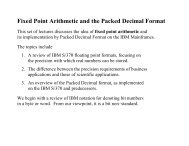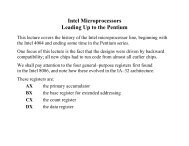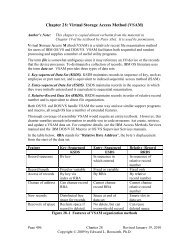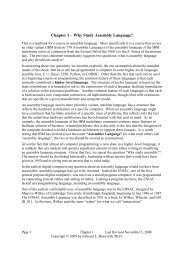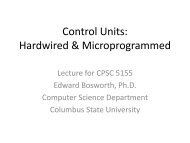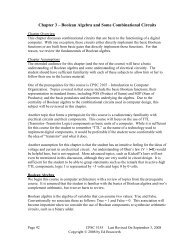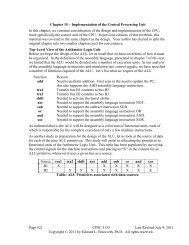Microprogramming: History and Evolution - Edwardbosworth.com
Microprogramming: History and Evolution - Edwardbosworth.com
Microprogramming: History and Evolution - Edwardbosworth.com
Create successful ePaper yourself
Turn your PDF publications into a flip-book with our unique Google optimized e-Paper software.
<strong>Microprogramming</strong>: The Late <strong>Evolution</strong><br />
―The Mc2 [microprogramming control] level was the st<strong>and</strong>ard design for practically all<br />
<strong>com</strong>mercial <strong>com</strong>puters until load/store architectures became fashionable in the 1980s‖.<br />
Events that lead to the reduced emphasis on microprogramming include:<br />
1. The availability of VLSI technology, which allowed a number of improvements,<br />
including on–chip cache memory, at reasonable cost.<br />
2. The availability of ASIC (Application Specific Integrated Circuits) <strong>and</strong> FPGA<br />
(Field Programmable Gate Arrays), each of which could be used to create<br />
custom circuits that were easily tested <strong>and</strong> reconfigured.<br />
3. The beginning of the RISC (Reduced Instruction Set Computer) movement, with<br />
its realization that <strong>com</strong>plex instruction sets were not required.<br />
Modern design practice favors a ―mixed control unit‖ with hardwired control for the<br />
simpler (<strong>and</strong> more <strong>com</strong>mon) instructions <strong>and</strong> microcode implementation of the more<br />
<strong>com</strong>plex (mainly legacy code) instructions.<br />
The later versions (80486 <strong>and</strong> following) of the Intel IA–32 architecture provide a good<br />
example of this ―mixed mode‖ control unit. We examine these to close the lecture.<br />
(page 618 of Warford, 2005)



